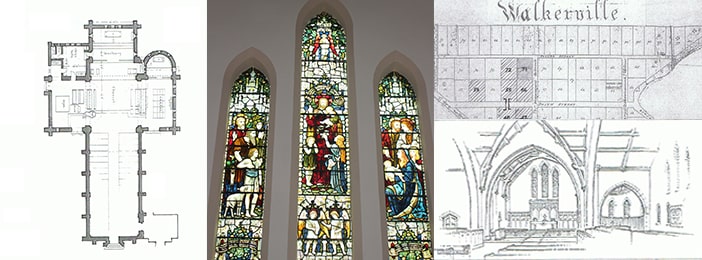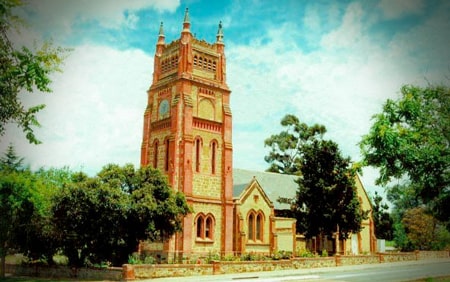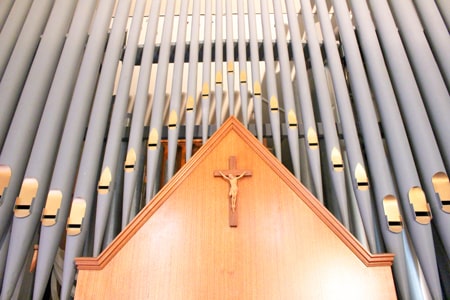Church Planning
In 1847, meetings were held at the Sussex Hotel, Walkerville Terrace to plan the building of a church in this area. The local brewer, William Williams gave the land and enthusiastic support was given by his friends. St Andrew’s was built and dedicated in 1848.
All the windows in this historic church are of stained glass and there are many other interesting features to engross the visitor.

Memorial Rose Garden
This was planted in 1963 on the Fuller Street boundary beside the church. It provides for the interment of ashes by families who wish to use such a facility. There are no fees, and no plaques installed. Ashes are technically scattered, which means they are not buried in a container.
Upon request some families have been permitted to contribute a memorial rose planting, according to the original layout and thus increasing the number of roses in the garden. The names of those whose ashes have been interred are written in a memorial book that is availble on request.
There are no restrictions on whose ashes may be buried in the Rose Garden. Although no fees are required you may wish to consider giving a donation to the work of the Church.
A short form of prayers is used when ashes are interred at a time convenient to the family. Or they may be interred at the end of a Sunday service.. Please speak to the Parish Priest to discuss the matter further.

The Stained Glass Windows
St Andrew’s Church is fortunate to have an extensive collection of stained glass windows, the majority of which are from the British Company of James Powell and Sons of Whitefriars. This firm was established in 1680 and did not begin making stained glass until the nineteenth century, when it revived the interest in medieval glass. By 1870, it became one of the most progressive firms making stained glass. During its history, the Whitefriars Studio boasted many eminent designers and their work is displayed in the windows of St Andrews.
Another company displaying windows at St Andrew’s is Morris and Co. The figures of St Gabriel and St Michael in the nave are designed by Burne-Jones, the most notable of Morris and Co.’s designers.
Conservation & Restoration
Overview
In 2006, St Andrew’s Church was listed on the State Heritage List and a plan to restore the Church was formed. The restoration is taking place in two stages: Stage One – the organ (completed in 2008); Stage Two – the building.
A fund was established in partnership with the South Australian National Trust to appeal for funds. Thanks to a generous response from the public, Stage One was completed in 2008 with the restoration and rebuild of the organ.
Restoration of the church building, including the interior, was carried out from 2012-13 with the advice of Heritage Architect Liz Vines, and the Heritage Stone Restorations. This formed a major part of the Stage Two development.
Funding is now required to complete repairs and restoration of the and bell tower. The remaining work involves repair of the roof. Without your generous donations, this work cannot be completed.
If you would like to donate to help preserve this church, please refer below.

Stage 1: The Organ – Completed

The Anglican Church of St Andrew, Walkerville in South Australia, is blessed with a pipe organ of special musical significance which has served well since the last major rebuild 44 years ago.
The Organ is used regularly to accompany the services at St Andrew’s Church and at significant festivals and other special occasions such as the many weddings and funerals held in the church.
The Organ is used for recitals, especially in the Adelaide Fringe Festival, for carol services and other special choral festivals.
The Organ was restored and completely rebuilt in 1962 as a War Memorial Organ. The former tuner, Mr Leith Jacob, who worked on the 1962 rebuild, completed the restoration and rebuilding of the organ in 2008. This was made possible by the generous response from parishioners over recent years who contributed to this stage of the project.
Stage 2: The Building

The Story of the Building
The Anglican Church of St Andrew, Walkerville in South Australia, was one of the earliest churches built outside the parklands of Adelaide and was the first church to be built free of debt.
Since its consecration on 23 August 1848, the church has undergone three major additions, with the combined result that none of the original 1848 fabric now remains. Although different materials were used for each addition, the church’s original Gothic revival style was maintained.
Adding to its early English Gothic appearance, St Andrew’s Church has an outstanding collection of late-nineteenth and early-twentieth century stained-glass windows and a fine pipe organ.
The significance of the property in architectural, social and historical terms is well established. An extensive Conservation Management Plan was prepared by McDougall & Vines, Conservation & Heritage Consultants in 2010. The Parish is also working closely with Arcuate Architecture, and its Principal, Ian Hamilton. This provides a sound base for decisions around the conservation and ongoing management of St Andrew’s Church, to ensure that all future decisions are carried out with regards to its heritage significance.
The parish is currently seeking to raise a total of $700,000 for conservation work on the bells and bell-tower.
